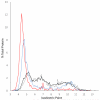Halophiles and their enzymes: negativity put to good use
- PMID: 26066288
- PMCID: PMC4729366
- DOI: 10.1016/j.mib.2015.05.009
Halophiles and their enzymes: negativity put to good use
Abstract
Halophilic microorganisms possess stable enzymes that function in very high salinity, an extreme condition that leads to denaturation, aggregation, and precipitation of most other proteins. Genomic and structural analyses have established that the enzymes of halophilic Archaea and many halophilic Bacteria are negatively charged due to an excess of acidic over basic residues, and altered hydrophobicity, which enhance solubility and promote function in low water activity conditions. Here, we provide an update on recent bioinformatic analysis of predicted halophilic proteomes as well as experimental molecular studies on individual halophilic enzymes. Recent efforts on discovery and utilization of halophiles and their enzymes for biotechnology, including biofuel applications are also considered.
Copyright © 2015 Elsevier Ltd. All rights reserved.
Figures


References
-
- DasSarma S, DasSarma P. Encyclopedia of Life Sciences. Wiley; London: 2012. Halophiles. DOI: 10.1002/9780470015902.a0000394.pub3.
-
- Bayley ST, Morton RA. Recent developments in the molecular biology of extremely halophilic bacteria. CRC Critical Reviews in Microbiology. 1978;6(2):151–205. - PubMed
-
- Dym A, Mavaerech M, Sussman JL. Structural features that stabilize halophilic malate dehydrogenase from an archaebacterium. Science. 1995;267:1344–1346. - PubMed
Publication types
MeSH terms
Substances
Grants and funding
LinkOut - more resources
Full Text Sources
Other Literature Sources

